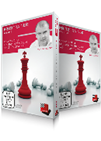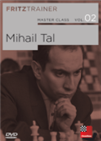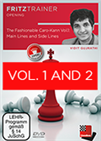High expectations
A very successful first event of the Grand Prix series in terms of entertainment value means chess enthusiasts expect to see yet another fighting, high-quality tournament. The new format, with a preliminary stage and a knockout stage, appears to be here to stay, as a high-risk, high-reward approach seems to be best suited to reach the knockout in the 4-player double round-robin prelims — only one player makes the cut in each pool.
 These DVDs are about Understanding Middlegame Strategies. In the first DVD dynamic decisions involving pawns are discussed. The second DVD deals with decision making process concerning practical play.
These DVDs are about Understanding Middlegame Strategies. In the first DVD dynamic decisions involving pawns are discussed. The second DVD deals with decision making process concerning practical play.Out of the sixteen participants set to play in Belgrade, nine will be making their debut in the series, including household names Anish Giri, Shakhriyar Mamedyarov and Maxime Vachier-Lagrave.
In the drawing of lots to decide who will play in each pool, the organizers place the four highest-rated players in different groups, then move on to the 5th-8th rated players, who also are placed in different groups, etcetera. Given the strength of the participants in Belgrade, French star Vachier-Lagrave falls in the second group (as the 5th seed), and is set to face Mamedyarov in the preliminaries.

All ready to stage the second stage of the Grand Prix in Belgrade | Photo: Mark Livshitz
While MVL and Shakh will have a tough time from the get go, the player who had the strongest performance in Berlin and is participating in Belgrade is Richard Rapport. The Hungarian grandmaster reached the semifinals in the first leg, where he was knocked out by eventual tournament winner Hikaru Nakamura. For Rapport, reaching semis in Belgrade will most likely not be enough to claim a spot in the Candidates, given the way Grand Prix points are awarded in the series.
- Winner - 13 points
- Runner-up - 10 points
- Semifinal loser - 7 points
- 2nd in pool - 4 points
- 3rd in pool - 2 points
- 4th in pool - 0 points
As we see above, reaching semis twice in the series only amounts to 14 points, which is a score almost impossible not to be surpassed by finalists of any of the three events.
Five Russians in the mix
For Alexander Grischuk, Nikita Vitiugov, Dmitry Andreikin, Vladimir Fedoseev and Alexandr Predke, adding up GP points is likely not a priority at the moment. The Russians will play with the uncertainty as to whether they will be allowed to participate in future tournaments in the back of their minds.
 On this DVD Dorian Rogozenco, Mihail Marin, Oliver Reeh and Karsten Müller present the 8. World Chess Champion in video lessons: his openings, his understanding of chess strategy, his artful endgame play, and finally his immortal combinations.
On this DVD Dorian Rogozenco, Mihail Marin, Oliver Reeh and Karsten Müller present the 8. World Chess Champion in video lessons: his openings, his understanding of chess strategy, his artful endgame play, and finally his immortal combinations.Major sports organizations, such as FIFA and UEFA, have already banned Russian teams from participating in any events ‘until further notice’, while the Olympic International Committee has recommended no participation of Russian and Belarusian athletes and officials.
Moreover, professional chess players, much like every other Russian citizen, must contend with the consequences of the financial sanctions that are stressing their country’s economy.
For the time being, as announced by the FIDE Council a few days ago, we expect not to see any Russian flag on display in Belgrade:
Following the call from IOC, the FIDE Council decides that no Russian and Belarusian national flag be displayed or anthem be played in all FIDE-rated international chess events. Instead – the national chess federation’s flag or the official symbol/logo shall be used. A simplified procedure for performing under the FIDE flag would be followed where it is crucial for the players or any other chess officials under the current geopolitical situation.
World Chess, the organizers of the series, has decided to change its logo into a sign of peace to show support for Ukraine and as a call for an immediate ceasefire.

Vladimir Fedoseev | Photo: World Chess
The pools
A 16-player event, the tournament consists of a group stage followed by a knockout semifinal and final. At the group stage, the participants compete in four double round-robin tournaments, with only the winners of each pool advancing. Both semifinals and the final consist of two classical games, plus tiebreaks if needed.
Pool A
- Alexander Grischuk (Russia), 2764
- Dmitry Andreikin (Russia), 2724
- Sam Shankland (USA), 2708
- Etienne Bacrot (France), 2642
Pool B
- Anish Giri (Netherlands), 2772
- Nikita Vitiugov, (Russia), 2726
- Pentala Harikrishna (India), 2719
- Amin Tabatabaei (Iran), 2623
 The Caro Kann is a very tricky opening. Black’s play is based on controlling and fighting for key light squares. It is a line which was very fashionable in late 90s and early 2000s due to the successes of greats like Karpov, Anand, Dreev etc. Recently due to strong engines lot of key developments have been made and some new lines have been introduced, while others have been refuted altogether. I have analyzed the new trends carefully and found some new ideas for Black.
The Caro Kann is a very tricky opening. Black’s play is based on controlling and fighting for key light squares. It is a line which was very fashionable in late 90s and early 2000s due to the successes of greats like Karpov, Anand, Dreev etc. Recently due to strong engines lot of key developments have been made and some new lines have been introduced, while others have been refuted altogether. I have analyzed the new trends carefully and found some new ideas for Black.Pool C
- Richard Rapport (Hungary), 2763
- Vidit Gujrathi (India), 2727
- Vladimir Fedoseev (Russia), 2704
- Alexei Shirov (Spain), 2704
Pool D
- Shakhriyar Mamedyarov (Azerbaijan), 2767
- Maxime Vachier-Lagrave (France), 2761
- Yu Yangyi (China), 2713
- Alexandr Predke (Russia), 2682

Full tournament regulations (PDF)...
Links


























